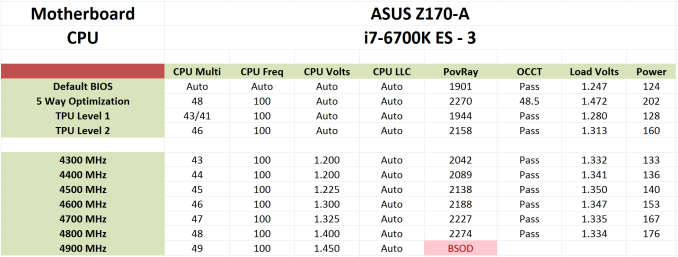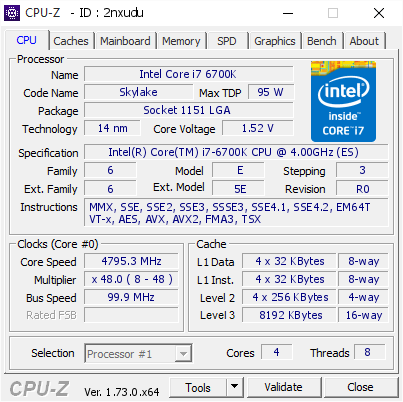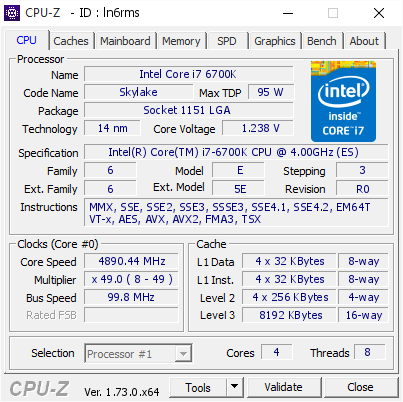The Intel Skylake i7-6700K Overclocking Performance Mini-Test to 4.8 GHz
by Ian Cutress on August 28, 2015 2:30 PM EST
At the time of our Skylake review of both the i7-6700K and the i5-6600K, due to the infancy of the platform and other constraints, we were unable to probe the performance uptake of the processors as they were overclocked. Our overclock testing showed that 4.6 GHz was a reasonable marker for our processors; however fast forward two weeks and that all seems to change as updates are released. With a new motherboard and the same liquid cooler, the same processor that performed 4.6 GHz gave 4.8 GHz with relative ease. In this mini-test, we tested our short-form CPU workload as well as integrated and discrete graphics at several frequencies to see where the real gains are.
In the Skylake review we stated that 4.6 GHz still represents a good target for overclockers to aim for, with 4.8 GHz being indicative of a better sample. Both ASUS and MSI have also stated similar prospects in their press guides that accompany our samples, although as with any launch there is some prospect that goes along with the evolution of understanding the platform over time.
In this mini-test (performed initially in haste pre-IDF, then extra testing after analysing the IGP data), I called on a pair of motherboards - ASUS's Z170-A and ASRock's Z170 Extreme7+ - to provide a four point scale in our benchmarks. Starting with the 4.2 GHz frequency of the i7-6700K processor, we tested this alongside every 200 MHz jump up to 4.8 GHz in both our shortened CPU testing suite as well as iGPU and GTX 980 gaming. Enough of the babble – time for fewer words and more results!


We actually got the CPU to 4.9 GHz, as shown on the right, but it was pretty unstable for even basic tasks.
(Voltage is read incorrectly on the right.)
OK, a few more words before results – all of these numbers can be found in our overclocking database Bench alongside the stock results and can be compared to other processors.
Test Setup
| Test Setup | |
| Processor | Intel Core i7-6700K (ES, Retail Stepping), 91W, $350 4 Cores, 8 Threads, 4.0 GHz (4.2 GHz Turbo) |
| Motherboards | ASUS Z170-A ASRock Z170 Extreme7+ |
| Cooling | Cooler Master Nepton 140XL |
| Power Supply | OCZ 1250W Gold ZX Series Corsair AX1200i Platinum PSU |
| Memory | Corsair DDR4-2133 C15 2x8 GB 1.2V or G.Skill Ripjaws 4 DDR4-2133 C15 2x8 GB 1.2V |
| Memory Settings | JEDEC @ 2133 |
| Video Cards | ASUS GTX 980 Strix 4GB ASUS R7 240 2GB |
| Hard Drive | Crucial MX200 1TB |
| Optical Drive | LG GH22NS50 |
| Case | Open Test Bed |
| Operating System | Windows 7 64-bit SP1 |
The dynamics of CPU Turbo modes, both Intel and AMD, can cause concern during environments with a variable threaded workload. There is also an added issue of the motherboard remaining consistent, depending on how the motherboard manufacturer wants to add in their own boosting technologies over the ones that Intel would prefer they used. In order to remain consistent, we implement an OS-level unique high performance mode on all the CPUs we test which should override any motherboard manufacturer performance mode.
Many thanks to...
We must thank the following companies for kindly providing hardware for our test bed:
Thank you to AMD for providing us with the R9 290X 4GB GPUs.
Thank you to ASUS for providing us with GTX 980 Strix GPUs and the R7 240 DDR3 GPU.
Thank you to ASRock and ASUS for providing us with some IO testing kit.
Thank you to Cooler Master for providing us with Nepton 140XL CLCs.
Thank you to Corsair for providing us with an AX1200i PSU.
Thank you to Crucial for providing us with MX200 SSDs.
Thank you to G.Skill and Corsair for providing us with memory.
Thank you to MSI for providing us with the GTX 770 Lightning GPUs.
Thank you to OCZ for providing us with PSUs.
Thank you to Rosewill for providing us with PSUs and RK-9100 keyboards.










103 Comments
View All Comments
MikeMurphy - Saturday, January 30, 2016 - link
Tragically, few stress testing programs cycle power states during testing, which is important. Most just place CPU under continuous load.0razor1 - Friday, August 28, 2015 - link
Didn't mean memcheck - it's error check on regular OCCT :GPU.Xenonite - Saturday, August 29, 2015 - link
Different parts of the CPU are fabricated to withstand different voltages. The DRAM controller is only optimised for the lowest possible power/performance, so the silicon is designed with low leakage in mind.As another example, the integrated PLL runs at 1.8V.
Electron migration is indeed the main failure mechanism in most modern processors, however, the metal interconnect fabric has not been shinking by the same factors as the CMOS logic has. That means these 14nm processors can take more voltage than you would expect from a simple linear geometric relationship.
What exactly the maximum safe limits are will probably never be known to those outside of Intel, but just as with Haswell, I've been running at a 24/7 1.4V core voltage, which I don't believe will significantly shorten the life of the CPU (especially if you have the cooling capacity to up the voltage to around 1.55V as the CPU degrades over the following decade).
In any case, NOT running the CPU at at least 4.6GHz would mean that it wasn't a worthwhile upgrade from my 5960X, so the safety question is pretty much moot in my case.
Oxford Guy - Saturday, August 29, 2015 - link
Unless that worthwhile upgrade burns up in which case it's a non-worthwhile downgrade.0razor1 - Sunday, August 30, 2015 - link
Hey @Xenonite, sorry to quote you directly..'Electron migration is indeed the main failure mechanism in most modern processors, however, the metal interconnect fabric has not been shinking by the same factors as the CMOS logic has'
-> I'd say spot on. But I thought that's what Intel 14nm was all about -they had the metal shrunk down to 14nm as well, as opposed to what Samsung as a pseudo 14nm (20nm metal interconnect).
just as with Haswell, I've been running at a 24/7 1.4V core voltage
-> Intel has specified 1.3VCore as being the max safe voltage. I'd pay heed :)
NOT running the CPU at at least 4.6GHz would mean that it wasn't a worthwhile upgrade from my 5960X, so the safety question is pretty much moot in my case.
-> You're right. But then everyone can't afford upgrades. I've just come from a Phenom 2 @4GHz (1.41VCore) to a 4670k @ 4.6GHz (1.29/1.9 core/VDDIN). What I did do was once the Ph2 was out of warranty, lapped it and OC'd it as far as it would go. Tried my hands at an FX -6300 for a week and was disappointed to say the least.
Long story short and back to my point, P95.
If it doesn't P95, it corrupts. /motto
varg14 - Friday, September 4, 2015 - link
I agree if you have good cooling like my Cooler Master Nepton 140XL on my 4.6-5.1ghz 2600k that uses motherboard VRM's and keep temps under 70c always I see no reason to see any chip degradation or failures. I really only heard of chip degradation and failures when they started putting the VRM's on the CPU die itself with haswell adding more heat to the CPU. Now with Skylake using motherboard VRM;s again everything should be peachy keen.StevoLincolnite - Saturday, August 29, 2015 - link
Electromigration.I was going those volts at 40nm...
0razor1 - Sunday, August 30, 2015 - link
Lol I topped out @ 1.41Vcore on 45nm Phenom 2 ( with max temps on the core of 60C @ 4GHz).Earlier 24x7 for three years was 1.38Vcore for 3.8GHz.
JKflipflop98 - Sunday, September 6, 2015 - link
"If it's OK, then can someone illustrate why one should not go over say 1.6V on the DRAM in 22nm, why stick to 1.35V for 14nm? Might as well use standard previous generation voltages and call it a day?"Because the DRAM's line voltage goes straight into the integrated memory controller within the cpu. While the chunky circuits in your ram modules can handle 1.6V, the tiny little logical transistors on the CPU can only handle 1.35 before vaporizing.
Zoeff - Friday, August 28, 2015 - link
Yeah that's what I thought as well but apparently the voltage in the silicon is lower compared to what the input voltage is which is what you can control as the user. At least, this is what I read on overclock.net. Right now CPUz reports ~1.379v (flicking, +/- 0.01v) and that's with EIST, C-States and SVID Support disabled. Different monitoring software sometimes reports different voltages too so I find it hard to check what my CPU is actually doing.